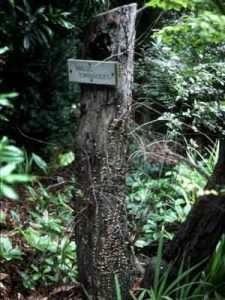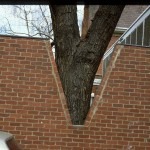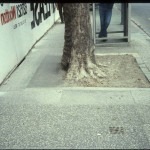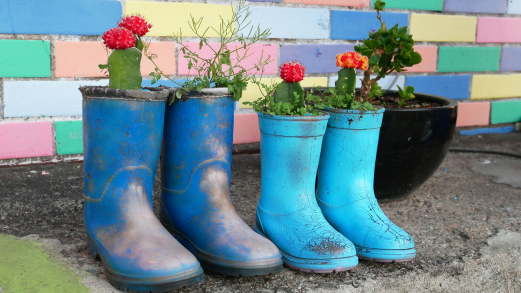Given the splendour and usefulness of trees in the urban environment, it is really amazing what otherwise sensible and apparently sane people do to them. All too often people forget the basics – that trees are alive and should be treated as living things. This is one of the most important messages that I can give about trees. If taken to heart then trees will not only be treated with the respect that all living things deserve, but also we may avoid many common and potentially dangerous problems.
 How often have you see signs nailed into a tree? I have seen a whole planting of mature trees seriously damaged by people nailing signs for weekend garage sales onto their trunks.
How often have you see signs nailed into a tree? I have seen a whole planting of mature trees seriously damaged by people nailing signs for weekend garage sales onto their trunks.
No one would approach something that they see as a living thing with a hammer and nail into its structure. These people are probably not villains! They just see the trees as lampposts with leaves, and don’t realise that they are doing serious long term damage.
As with all living things, trees grow and respond to changes in their environments. We all know this but when a blue gum (Eucalyptus globulus) is planted as a small tree from a nursery container, placing it 20 cm from a brick wall is not a good idea! This species can easily grow to 10m in a few years, on its way to a mature height of over 30m and with a trunk in excess of 1m in diameter. When it starts to lift the foundation and crack the wall, it is the tree that is blamed not the person who planted it. They forgot that it was alive and growing.
I have seen many trees planted under the eaves of a house or on the south wall in almost constant shade. These trees may grow away from  the house leading to a sickly and poorly structured specimen, which is often later removed. What a waste of time, resources and opportunity! However, I have seen one specimen that grew under the eave and lifted the roof right off the wall, causing serious damage to the house. While a tree getting revenge has some appeal, who could forget that trees get taller as they grow?
the house leading to a sickly and poorly structured specimen, which is often later removed. What a waste of time, resources and opportunity! However, I have seen one specimen that grew under the eave and lifted the roof right off the wall, causing serious damage to the house. While a tree getting revenge has some appeal, who could forget that trees get taller as they grow?
 How many trees have you seen planted or growing in paving, bitumen or concrete? Trees need space both above and below ground. A large tree always has a large root system, even if you can’t see it and much of it is in neighbouring properties. Most of the roots are close to the surface, so the root plate tends to be shallow and spreading. The root system develops this way because most of the roots will be where the moisture, nutrients and oxygen are located. So plant where there is sufficient space and don’t pave around or under the tree if you want to avoid trouble and expense.
How many trees have you seen planted or growing in paving, bitumen or concrete? Trees need space both above and below ground. A large tree always has a large root system, even if you can’t see it and much of it is in neighbouring properties. Most of the roots are close to the surface, so the root plate tends to be shallow and spreading. The root system develops this way because most of the roots will be where the moisture, nutrients and oxygen are located. So plant where there is sufficient space and don’t pave around or under the tree if you want to avoid trouble and expense.
The root systems of trees are often the victims of thoughtless actions. Most people still think that mature trees have a huge tap root that keeps them safe in the ground, but this is rarely the case. For many species the tap root, if it exists at all in urban areas, is a juvenile characteristic that is soon lost. So it is the extensive lateral roots with occasional descending roots that anchor the trees. So don’t cut lateral roots, especially if they are large (greater than 75mm) in diameter. This can have a serious impact on tree health and vigour as well as threatening the trees stability.
Each year, as a new tree grows over the old wood, the older roots gradually increase in diameter. Eventually they come to the surface and push up the surface soil. You can’t do anything about this – this is what trees do! So don’t cut the roots or mow over them re-wounding the roots every time you mow. This can cause the roots to decay, which again affects tree health and stability.
As often happens with trees in urban environments, the failure of trees has less to do with nature and more to do with our management practices. Too often the advice of horticulturists and arborists is either not requested or ignored by those managing our landscapes. The understanding of trees as living things and our knowledge of their root systems and response mechanisms has expanded enormously over the past decade or two. We can no longer use ignorance as an excuse for the often terrible things we do to trees in urban areas!
We have the knowledge to manage trees wisely and well to maximise both their longevity and the aesthetic contribution to our environment. By treating them as sophisticated living things, and providing appropriate growing conditions, we can avoid the high costs of the terrible things that people do to trees!
References
Harris, R.W., N. Matheny and J.R. Clark. 2004. Arboriculture. Integrated Management of Tree Shrubs and Vines in the Landscape, 4th Ed. Prentice Hall, New Jersey.
Anon, 2009. Protection of Trees on development sites, Australian Standard # 4970, Standards Australia, Sydney.
Article and photos copyright to Greg M. Moore, Senior Research Associate, Burnley College, University of Melbourne
Related Articles:
Citizen Science: A Pathway to Gardening Success and Biodiversity Conservation
In recent years, the realm of science has experienced a remarkable transformation, one that invites people from all walks of life to participate…
A Sustainable Gardener’s Guide to Thrifty Gardening
Creating an eco-friendly and cost-effective garden involves more than just nurturing plants; it's about adopting a sustainable approach that…




